This summer in the Public Humanities Collaborative (PHC), 5 teams of students, faculty, and community partners across fields came together to tell stories here in Hartford. Teams worked on projects on genealogy, Indigenous history, walking tours, urban ecology, incarceration, and neurodivergence.
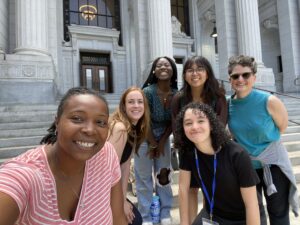
Over the course of ten weeks, students spent 15 hours a week with a faculty member on humanities-oriented scholarship (such as journal articles or book chapters) and another 15 hours a week with a community partner on public humanities projects (such as oral history collections, archival projects, interactive websites, curriculum development, exhibits, public programming, and more).
The program, which prioritizes students of color, first-generation college students, and students with financial need, also facilitates weekly workshops where project teams learn about public and digital humanities tools, hear from panelists in the field, and connect with the other members of the program. PHC offers an opportunity for humanities fieldwork while matching students with partners based on aligning passions and skill sets. Together, faculty and community partners interview and connect with their student researchers prior to the start of the program, which helps to establish strong, meaningful relationships between team members.
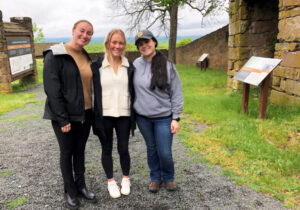
Trinity’s research librarians and instructional technologists are integral to the collaborative. This summer, Mary Mahoney, Cait Kennedy, David Tatem, and Cheryl Cape, guided PHC teams in exploring a variety of digital resources to accomplish their research goals and also helped students develop digital portfolios to showcase their work. “The best part of my job is getting to support people in making things with digital tools and technology and to strategize with them about what success looks like and how I can help them get there. I love watching what teams create every summer. Routinely, I am amazed at the end of the summer when I see the final products,” says Mary Mahoney, Digital Scholarship Strategist.
Teams built websites, story maps, research databases, walking tours, and oral histories. Read more about each project below.
The Promise of the Suburbs & Documenting Black Stories in Connecticut
Neema Kimondo ‘23, Reese San Diego ‘25, Professor Sarah Bilston, and community partners Christine Pittsley, CT State Library, and Adrienne Billings-Smith, Concerned Parents of Color West Hartford
Neema and Reese worked together to tell stories all the way from London to right here in Hartford. Working with Sarah Bilston, Professor of English, Neema and Reese assisted in continuing Bilston’s research on the suburbs of Victorian England. Neema and Reese created a digital map of suburban Victorian England by synthesizing post office directories and census data. They also composed brief narratives about the members of the household, their occupations, and how they lived their life.
Working with their community partners, Neema and Reese contributed to Belonging: The Augusta Loomis Project, a genealogical research project focused on tracing the lineage of Augusta Loomis, a biracial woman whose story was erased from her family tree. Neema and Reese conducted archival research and oral history interviews with family members. They also created a website that houses oral histories, a family photo album, resources on how to do your own genealogy, and a video overview of the project. Visit the website here to learn more about Belonging: The Augusta Loomis Project.
Neema reflects on her experience this summer, “Applying to be part of the Public Humanities Collaborative program was one of the best decisions I made this past summer. My favorite part of this project was creating ‘how-to’ digital resources to help people trace their own genealogy. This was a fun way of making our research accessible to others.”
“With access to a virtual space where Black stories can be archived, people can learn about their families, communities, and history. This work is so important to cultural sustainability and the bridging of lost connections. PHC has spring-boarded my project into real-time and space—which will allow me to continue working with communities and gathering stories of Black trauma, joy, and love” says community partner, Billings-Smith.
Hartford’s Indigenous History & Frog Hollow Storytelling
Max Norteman ‘23, Isabelle Says ‘23, Professor Garth Myers, and community partner Logan Singerman, Southside Institutions Neighborhood Alliance (SINA)
Isabelle and Max worked with Professor Garth Myers, expanding on his research about Connecticut Indigenous historical geography. Based on Myers’ 2020 book, Rethinking Urbanism, and his 2021 Hartford-based chapter on the Making of Global Cityscapes in The Handbook of Historical Geography, Isabelle and Max conducted archival research focusing on the history of Suckiaug (Hartford) and Pyquaog (Wethersfield) people. Specifically, Isabelle and Max explored the shifting dynamics of Indigenous relations with Dutch and English colonizers, looking at how colonial urbanism overtook, displaced, and subjugated Indigenous peoples.
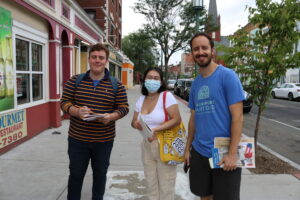
PHC also serves to sustain partnerships, advancing the work of already established collaborations between Trinity and community partners. Started in the Fall of 2021, the Frog Hollow People’s Oral History Project was created through a partnership between the Southside Institutions Neighborhood Alliance (SINA) and the Liberal Arts Action Lab. Collaborating with Frog Hollow community members, students created an archive housing oral narratives, public art, and other pillars of community history and storytelling.
The project has gone through several phases of collaboration with Trinity. In spring 2022, a group of Community Action Gateway students continued the project by creating walking tour lines that map out and feature content from the archive. This summer, Max, Isabelle, and Logan continued the project by taking the established tour lines and putting together a website. Logan speaks about the development of the project over time, “It was through conversations with Trinity College and the partnerships spanning multiple semesters which enabled us to make this idea a reality. Each group of students and faculty brought their own creativity and expertise and left their mark on the project. The final product would truly not have been possible without them.”
Olmsted 200 and Hartford Urban Ecology
Eloise Gerry ‘25, Jeremias Vazquez ‘23, Professor Susan Masino, and community partner Herb Virgo, Keney Park Sustainability Project
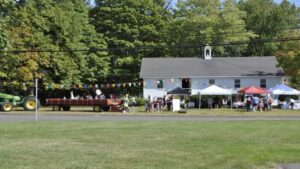
Eloise and Jeremias worked with Professor Susan Masino to celebrate the Olmsted 200 anniversary. Olmsted programming promotes the work and ideology of Frederick Law Olmsted, a landscape architect with a passion for the intersection of nature and brain health. Eloise and Jeremias worked with Professor Masino, assessing trees on campus for a future arboretum and compiling research sources related to nature and brain health in a Zotero database. They also set up Olmsted panels at community events and assisted with Olmsted 200 programming throughout the summer.
With Herb Virgo of the Keney Park Sustainability Project Urban Ecology Wellness Center, Eloise and Jeremias assessed and planned a new trail at Keney Park. They worked with specialists across fields to do assessment trail walks and also independently researched Keney Park’s history to identify points of interest. Together, they created a History Pin story map that highlights important historical and ecological sights at Keney Park. Check out the map here.
Humanizing History at Old-New Gate Prison
Zoë Gill ‘23, Madison Wilson ’23, Professor Glenn Falk and community partner Morgan Bengel, Old-New Gate Prison
With Professor Glenn Falk, Zoë and Madison investigated the history of the United States prison system and the roots of mass incarceration. Zoë and Madison worked with archival collections from the late eighteenth through the early twentieth centuries, organizing and transcribing trial court and prison records, newspaper accounts, petitions for clemency and early release, and files on methods of execution.
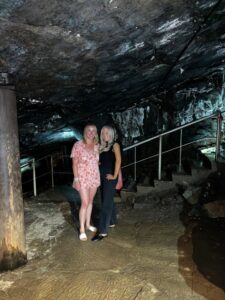
With Morgan Bengel, Museum Curator and Site Administrator, Zoë and Madison worked to tell the stories of those previously imprisoned at the Old-New Gate Prison. Old New-Gate, now a state-run museum in East Granby, initially operated as a copper mine, which was later abandoned and became a prison in 1773. Zoë and Madison explored archives at the Connecticut State Library, analyzing prison records and newspapers to piece together and humanize the stories of the imprisoned. Zoë and Madison created a website to house their research, including data visualization of convictions, as well as interactive story maps where visitors can learn more about the individual stories of the imprisoned. Read more about the project here.
Telling Our Stories Online and the Hartford Montford Point Marines
Myri Ayala ‘25, Chris Cooper ‘23, Mary Mahoney, Digital Scholarship Coordinator, Cait Kennedy, Research Technology and Outreach Librarian; and community partner Desiree Primus
Myri and Chris worked with Mary Mahoney and Cait Kennedy to compile online resources for students and faculty, with the goal of developing a more robust digital scholarship community at Trinity. Chris created a website that provides tips and tutorials to aid students in developing their personal portfolios. Myri’s website provides resources on data visualization.
With their community partner, Desiree Primus, Myri and Chris conducted interviews and archival research to tell the story of the nation’s first Black Marines: the Montford Point Marines. Desiree’s father, Clifford Primus, was a member of the combat unit in WWII. Drawing on Desiree’s previous research, Myri and Chris put together a website that further highlights her father’s story and incorporates oral narratives.
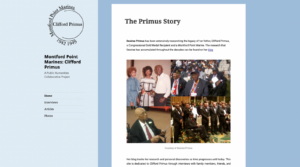
Locating Black Autism and Neurodivergence
Isabelle Duval ‘23, Professor Diana Paulin, CT Historical Society
This summer, Isabelle worked with Professor Paulin to continue her on research locating Black autism and neurodivergence. Professor Paulin’s research seeks to “carve out space for Black Autists, educators, researchers, family members, caregivers, and allies to intervene in ableism, reductive representations, and pathologizing erasures of Black neurodivergent lives and experiences.” Isabelle worked with archival materials in the Yale Medical Library, locating specific cases of Black autism and neurodivergence. Isabelle speaks about their experience working in PHC this summer, “Trying to look for Black neurodivergence in the archives is sort of like looking for a needle in a haystack. Sometimes you just go down rabbit holes, so it’s really exciting when you actually find something. You really have to read behind the lines when looking at these studies. It definitely enhanced my close reading skills.”
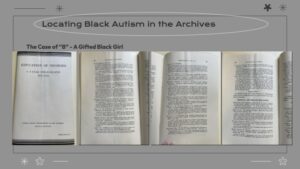
The Public Humanities Collaborative (PHC) is a summer research opportunity that brings together students, faculty, and individuals and organizations in Hartford to work on public humanities projects. The 2022 PHC is a component of Trinity College’s Summer Research Program funded by the Dean of Faculty’s Office. PHC is a competitive application process, with preference given to first generation, under-represented, and other students with demonstrated financial need, for whom socio-economic status has prevented them from engaging with summer research opportunities.
